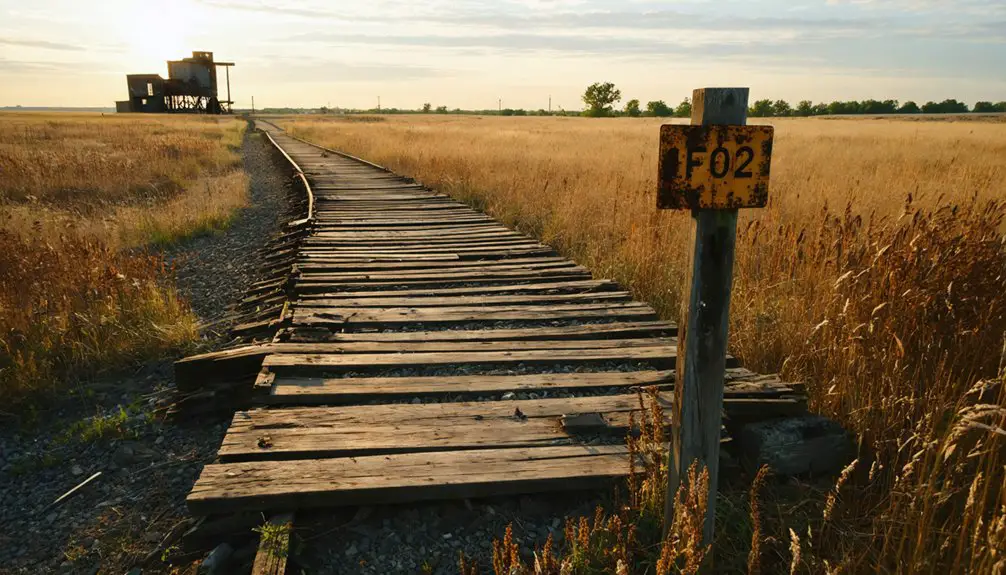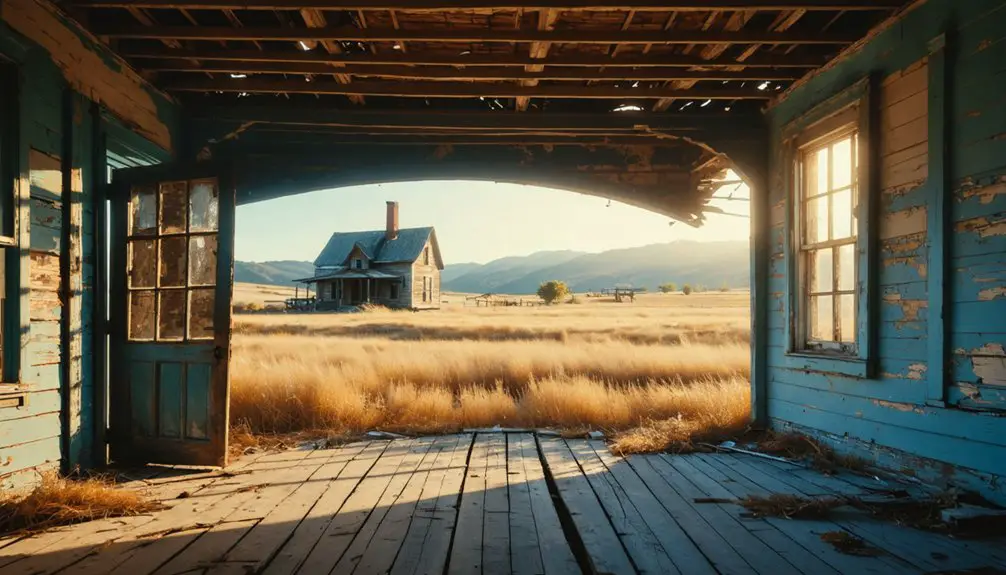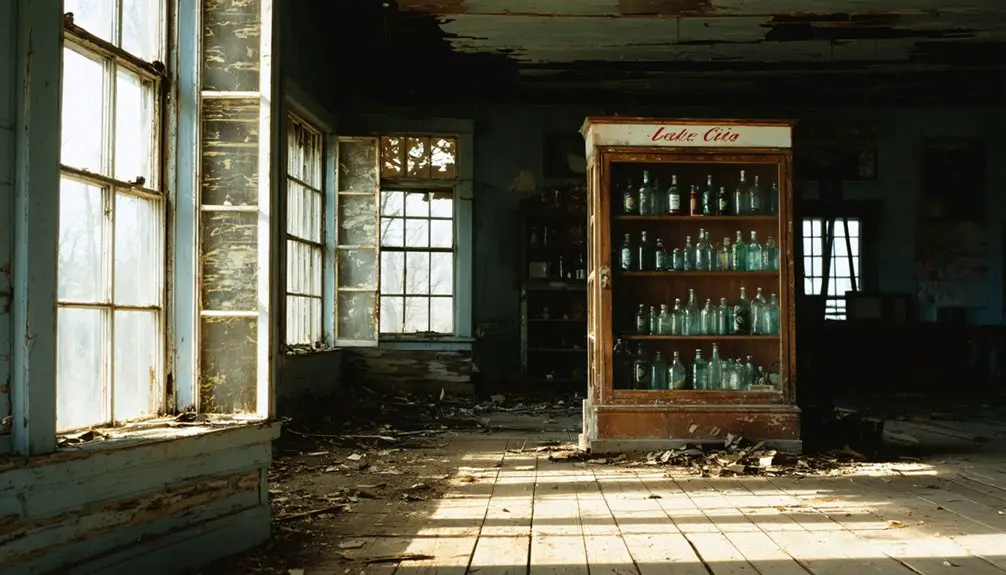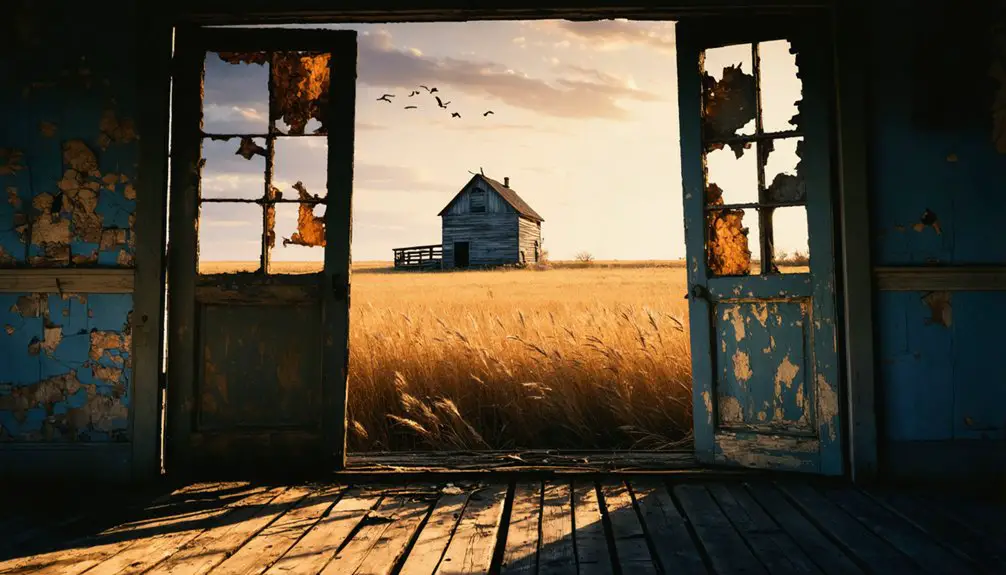You’ll find Lake City nestled along the Medicine Lodge River in Barber County, Kansas, where Reuben Lake established this frontier settlement in 1873. At its peak in the 1880s, the town boasted 350 residents, a bank, hotel, and thriving business district. While the community declined after World War I and lost its post office in 1990, you can still explore several original structures, including the 1878 Methodist Church, amid the dramatic red buttes of the Gypsum Hills.
Key Takeaways
- Lake City, Kansas was established in 1873 by Reuben Lake and reached a peak population of 350 residents in the 1880s.
- The town once thrived with a bank, hotel, blacksmith shop, and general store before declining after World War I.
- Abandoned Santa Fe Railroad plans contributed significantly to Lake City’s eventual transformation into a ghost town.
- The post office closure in 1990 marked a final milestone in Lake City’s decline from prosperous frontier town.
- Several original structures remain today, including the 1878 Methodist Church and district school building from the late 1800s.
The Birth of a Prairie Settlement
While many Kansas frontier towns emerged during the 1870s, Lake City’s story began on April 6, 1873, when Illinois native Reuben Lake established this prairie settlement in northern Barber County.
You’ll find Lake City nestled in a deep valley along the Medicine Lodge River, surrounded by the rugged Gypson Hills cattle country.
Despite settler challenges like Indian raids and the burning of Lake’s sawmill, the community’s foundations grew steadily. The raids were particularly concerning through spring of 1874, prompting citizens across the county to build protective stockades.
Early settlers faced raids and destruction, yet Lake City’s pioneering spirit remained unshaken as the community pushed forward.
By 1874, Lake had platted the town and opened a store, while Gideon C. Smith became the first postmaster.
Within five years, you’d have found a Methodist Church, district school, general store, and even professional services like a lawyer and physician serving the town’s 40 residents, making Lake City a small but determined frontier hub. The town’s future looked promising when the population reached 350 early residents in the 1880s.
Natural Beauty of the Gypson Hills
You’ll find yourself surrounded by the striking red buttes and mesas of the Gypsum Hills, where ancient seabeds left behind dramatic rock formations that define the landscape around Lake City.
The Medicine Lodge River winds through this rugged terrain, carving paths between iron-rich cliffs and creating sheltered valleys where diverse prairie wildflowers bloom in season. These dramatic cliffs showcase layers of red mud rocks deposited around 260 million years ago. The area’s distinct landscape stands apart from typical Kansas plains due to its undulating terrain.
The area’s unique geology supports a rich tapestry of plant life, from hardy grasses clinging to the rocky outcrops to colorful wildflower meadows that blanket the gentler slopes in spring and summer.
Majestic Limestone Rock Formations
Nestled within south-central Kansas, the majestic Gypsum Hills showcase a stunning array of limestone and gypsum formations that date back 260 million years to the Permian Period.
You’ll discover distinctive geological features shaped by natural erosion, where resistant gypsum caps protect underlying layers of red shales and sandstones.
The formations stretch from northern Marshall County to southern Cowley County, creating a remarkable geological corridor across the state.
As you explore the terrain, you’ll encounter dramatic limestone formations at Mount Nebo (2,441 ft), Mount Jesus (2,340 ft), and Mount Lookout (2,320 ft).
These peaks offer sweeping views of the surrounding landscape, where erosion has carved out steep canyons and exposed ancient sedimentary sequences.
The region’s unique topography stands in stark contrast to the typical Great Plains, featuring gypsum-capped mesas, natural terraces, and striking buttes that create an otherworldly panorama along the Gypsum Hills Scenic Byway. The gypsum outcrops are particularly prominent on south valley walls, creating dramatic cliff faces that catch the sunlight.
Wildflower-Dotted Prairie Meadows
The vibrant meadows of the Gypsum Hills transform the rugged limestone landscape into a living tapestry each spring and summer.
You’ll discover native wildflowers bursting with color against the rust-red soil, creating spectacular displays that change with each passing season. These wildflower habitats thrive alongside buffalo grass, bluestems, and Indian grass in the diverse prairie ecosystem. The scenic byway offers stunning panoramic views of these colorful meadowlands.
As you explore these untamed meadows, you’ll notice they’re more than just scenic wonders. They’re bustling communities where prairie pollinators, including native bees and butterflies, dance from bloom to bloom.
The dynamic boundaries of these meadows shift with the terrain’s elevation, while deer and pheasants make their home among the flowers. Nature’s careful balance here supports both wildlife and traditional cattle grazing, preserving the land’s wild character. The area’s iron-rich red soil creates a striking contrast against the verdant prairie grasses and wildflowers.
Winding Medicine Lodge River
Spanning 130 miles through the heart of Kansas, Medicine Lodge River carves a dramatic path through the Gypsum Hills’ red sandstone terrain.
The ephemeral stream flows seasonally through the southeastern parts of Kiowa County before continuing its journey south.
You’ll discover a rich river ecology where flat valley floors meet towering mesas, creating diverse habitats along the winding waterway.
The river’s historical significance runs deep, as Native Americans considered these waters sacred, building medicine lodges on its banks for healing ceremonies. The Kiowa tribe believed the healing properties of the water could cure illnesses.
- Watch the river drop 700 feet in elevation as it flows southeast from Kiowa County
- Explore fertile valleys where natural vegetation thrives in the semi-arid environment
- Stand where the 1867 Medicine Lodge Peace Treaty changed Plains Indian history
- Trek through canyons and bluffs shaped by the river’s persistent erosion
Early Business and Community Life
Founded by Reuben Lake in 1873, Lake City quickly established itself as an essential trading hub in southwestern Barber County.
You’d have found Lake’s sawmill along the Medicine Lodge River and his general store serving early settlers’ needs.
The town’s first post office opened that December, with Gideon C. Smith managing mail services.
The Railroad That Never Was

During the early 1880s, Lake City’s promising future hinged on a planned Atchison, Topeka & Santa Fe Railroad extension from Medicine Lodge. The town’s railroad ambitions seemed within reach as the company secured right-of-way access and completed the initial grading work.
However, these unfulfilled connections would ultimately impact the community’s destiny.
- The railroad company made substantial preparations, demonstrating their serious intent to connect Lake City.
- A thriving local newspaper and significant buildings showed Lake City was ready for rail service.
- The reasons behind the railroad’s decision to abandon the project remain a mystery.
- Without rail access, Lake City faced economic disadvantages compared to neighboring towns that secured railroad connections.
This missing link in transportation infrastructure would prove significant for Lake City’s future development and eventual decline.
Economic Rise and Fall
The railroad’s absence set the stage for Lake City’s dramatic economic trajectory over the next century. Despite this setback, you’d have witnessed remarkable community resilience in the 1880s when the population reached 350.
The town boasted a diverse commercial hub with a bank, blacksmith shop, general store, and even an opera room in Reuben Lake’s brick building. Local economic sustainability seemed promising with the town’s robust infrastructure – a bridge across Medicine River, a 20-room hotel, and telegraph offices.
Lake City flourished with banks, shops, and grand buildings, its infrastructure suggesting a bright future for this bustling frontier town.
By 1910, Lake City supported daily stage service and a money order post office. However, without major transportation links or industrial development, the town couldn’t maintain its momentum.
After World War I, the population declined steadily, leading to institutional closures, including the post office’s suspension in 1990.
Standing Buildings and Lost Structures

While many prairie towns have vanished without a trace, Lake City’s architectural heritage endures through several original structures from its settlement period. The town’s historic preservation efforts have helped maintain buildings that showcase late 19th-century architectural significance, including the Methodist Church established in 1878.
You’ll find simple wood-frame construction using local lumber, reflecting the practical nature of frontier buildings.
- The Methodist Church stands as one of the earliest structures, featuring classic frontier elements and a modest steeple.
- Several residential homes built with lumber from the original sawmill remain inhabited or converted.
- The district school building from the late 1800s continues to mark the town’s educational history.
- Remnants of the general store, once central to Lake City’s economy, preserve its commercial legacy.
Stories From Former Residents
Through oral histories and written accounts, former Lake City residents paint a vivid picture of the town’s early frontier life. Their personal anecdotes tell of Reuben Lake’s ambitious vision when he founded the settlement in 1873, establishing a sawmill and general store in the scenic valley near Medicine Lodge River.
Former residents recall a bustling community that peaked at 350 people in the early 1880s, with twice-weekly mail delivery and daily stage connections to Medicine Lodge. They describe a self-sufficient town where ranching drove the economy, and local businesses served both townspeople and rural neighbors.
The most poignant memories center on the devastating impact of the abandoned Santa Fe Railroad plans, which former residents identify as the turning point that ultimately led to Lake City’s decline into a ghost town.
Legacy in Kansas Ghost Town History

You’ll find Lake City’s decline mirrors dozens of Kansas ghost towns that lost their liveliness when promised railroad connections failed to materialize.
Though Lake City’s population dwindled from 350 residents to just 47 today, its remaining structures and community layout showcase typical patterns of 1870s rural settlement in the American West.
The town’s legacy lives on through its preserved Methodist church building and original street grid, offering valuable insights into how transportation access shaped the survival or abandonment of frontier communities.
Historical Transportation Impact
Since railroads shaped the destiny of countless Kansas frontier towns, Lake City’s transportation legacy mirrors a common pattern seen across the state’s ghost towns. The town’s transportation evolution reflects the essential connection between rail service and community survival, operating until the 1990s.
You’ll find that freight significance played a pivotal role in Lake City’s development, as the railroad facilitated important shipments from major hubs like Hutchinson, 75 miles away.
- Rail service supported Lake City’s postal operations from 1873 until the post office’s closure in 1993
- The town served as a key transfer point between rail freight and local distribution networks
- Transportation infrastructure influenced settlement patterns and population changes
- Lake City’s decline accelerated when rail service ended, affecting both commerce and communication
Rural Settlement Patterns
Beyond the rail lines that shaped Lake City’s rise and fall, the story of rural settlement patterns reveals deeper historical layers in Kansas ghost towns.
You’ll find Native American settlements, particularly those of the Kansa and Osage tribes, established the earliest community foundations along the region’s waterways. When you trace Lake City’s development, you’re witnessing the complex overlay of indigenous trading routes and later European-American settlement attempts.
The town’s eventual decline mirrors a common pattern you’ll see across Kansas, where agricultural mechanization transformed the rural landscape. As farms consolidated and families needed fewer workers, the town’s population dwindled.
Like many communities born from land speculation and booster dreams, Lake City couldn’t sustain itself when rural migration accelerated, leaving behind echoes of both native and settler histories in its abandoned streets.
Architectural Heritage Remains
While Lake City’s story echoes through time, its architectural heritage remains to tell the most tangible tales of frontier life.
You’ll find the Methodist Church standing as the town’s most significant surviving structure, embodying the architectural styles of 19th-century rural Kansas. Community structures once dotted the valley, built primarily from local timber processed at the now-vanished sawmill by Medicine Lodge River.
- The wood-frame buildings reflected frontier practicality, with simple designs prioritizing function over ornate details.
- Commercial structures featured characteristic flat-front facades typical of 1870s Kansas towns.
- The Methodist Church served as both a spiritual center and architectural anchor.
- School and general store buildings showcased vernacular design elements common to frontier settlements.
Today, these remaining structures serve as silent witnesses to Lake City’s brief but vibrant frontier period.
Frequently Asked Questions
Are There Any Paranormal or Haunted Locations Reported in Lake City?
You won’t find documented ghost sightings or haunted history here. While the town’s abandoned buildings might seem eerie, no paranormal activity has been officially reported in available historical records.
What Happened to the Original Residents’ Descendants?
Like scattered seeds in the wind, you’ll find descendants have mostly relocated to larger cities, though some maintain their family lineage through historical preservation efforts in nearby towns and Barber County.
Can Visitors Legally Explore the Remaining Structures in Lake City Today?
You’ll need to obtain exploration permits and landowner permission before entering any structures, as legal restrictions apply. Most buildings are on private property and require explicit access rights.
Which Original Buildings From 1873 Still Exist in Lake City?
Wondering about Lake City’s historical significance? You won’t find any original 1873 buildings still standing today – architectural styles and structures from that founding year have been lost to time and deterioration.
Were There Any Notable Crimes or Outlaws Associated With Lake City?
You won’t find any notorious outlaws or major crime history documented in this town’s records. While Reuben Lake served as sheriff, historical sources don’t mention significant criminal activity or lawless incidents.
References
- https://legendsofkansas.com/lake-city-kansas/
- https://www.ksgenweb.org/KSBarber/towns/lakecity.html
- https://legendsofkansas.com/kansas-ghost-town-list/
- https://www.youtube.com/watch?v=iB5rHT14eVI
- https://www.kcur.org/arts-life/2022-04-09/ghost-towns-are-all-around-kansas-city-if-you-know-where-to-look
- https://legendsofkansas.com/barber-county-kansas/
- https://www.kancoll.org/books/cutler/barber/barber-co-p1.html
- https://www.ksgenweb.org/KSBarber/earlyhist.htm
- https://www.glenelder.com/early-history.html
- https://www.youtube.com/watch?v=qK_QCNRwW60



